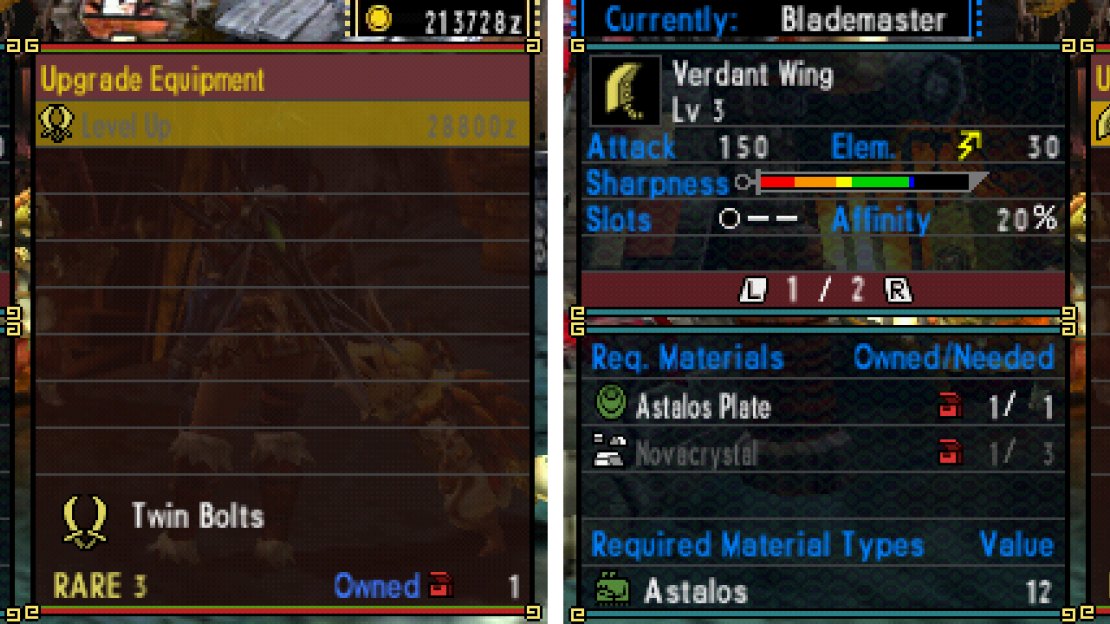Why do these two weapons have similar raw?
If you haven’t been to the Smithy yet, you really should, because otherwise you won’t be getting anywhere. And if you have been there, I’m sure you’ve noticed that every single weapon’s raw power is pretty…well…uniform. It doesn’t really make sense for a Great Sword to have 110 power and a Dual Blades to have 140 power, does it? What gives? Why use the Great Sword at all?
Well, if you’ve read the Motion Values section yet, you’ll understand why. The weapon power shown here is true damage potential as opposed to being readjusted to represent the weapons better conceptually. Numbers nerds will greatly enjoy this tweak, but beginner players will probably feel really confused. The raw power is the maximum numerical damage that you can deal to a monster. And it gets increased or decreased depending on the weapon’s sharpness (Blademaster only).
Here is a sharpness table to show you your multipliers for elemental and raw damage buffs or debuffs.
| Sharpness Color | Raw Multiplier | Elemental Multiplier |
|---|---|---|
| Red | 50% | 25% |
| Orange | 75% | 50% |
| Yellow | 100% (no change) | 75% |
| Green | 105% | 100% (no change) |
| Blue | 120% | 106% |
| White | 132% | 112% |
| Purple | 145% | 120% |
As you can see, staying at Green or above will guarantee that your damage is buffed or unchanged, and it adds up quickly. Sharpness multipliers are factored in before the monster’s defenses and resistances. You don’t need to be a master number cruncher to see that the increase in damage potential is huge and that it adds up very quickly! This is why the armor skills Sharpness+1 and Sharpness+2 are so coveted in this game.
Elemental Damage is also shown in its true damage form. So the numbers are small, but they do matter. Elemental damage will deal more or less damage depending on sharpness and the monster’s elemental resistances. Different parts have different percentages attached to them. These percentages indicate the percent of the true damage shown on a weapon’s stats that will actually affect the monster. For many monsters, several elements will do 0% damage to them. Most of the time it’s pretty obvious. Don’t go using a fire weapon against a Rathalos, for example! Or a Thunder weapon on Lagiacrus!
Weapons with larger motion values and thus larger inherent raw damage are far less dependent on effective elemental damage than weapons with smaller motion values. So when picking the weapons you want to forge in each category, keep that in mind. Great Swords, Hunting Horns, etc. are far less reliant on having high elemental damage than Dual Blades or Sword and Shield. Some weapons, like Long Sword and Insect Glaive, fall splat in the middle.
Finally we have status , which is an entirely different beast. The statuses in this game are: Poison, Sleep, Paralysis, KO, Fatigue, Blast, and Mount. Fatigue and Mount are affected by factors not related to what we are discussing here, so those will be left out. Status damage is independent of a monster’s part and more or less stands out on its own. Every monster has different thresholds for statuses. Some monsters are flat-out immune to certain statuses, others are very resistant, and others are really, really weak. For example, Duramboros has a very low tolerance to poison. This means the damage threshold you must meet is very low. Which is good because Duramboros is a damage sponge.
After inflicting a status once, it takes more hits to inflict it again. Sometimes the tolerance increases so much that you won’t be able to inflict it again before the monster is dead. In Duramboros’s case, the tolerance increase is rather small, so multiple poisons in one run are not impossible.
The status you see in a weapon’s stat has a 1/3rd chance of actually affecting a monster’s threshold. If it does hit, though (you know, 1 in every 3 hits), it will deal damage which contributes to the threshold. After the threshold is broken, the monster is afflicted. As you can see, weapons that attack fast deal status out faster than weapons that don’t, because of that 1/3rd chance. This makes Dual Blades and Sword and Shields prime status appliers in multiplayer. Their fast flurries of hits maximizes their chance to dish out status damage!

No Comments